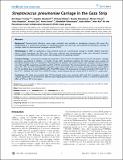| dc.contributor.author | Shainberg, Bracha | |
| dc.contributor.author | Varon, Miriam | |
| dc.contributor.author | Roytman, Yulia | |
| dc.contributor.author | Ziv, Arnona | |
| dc.contributor.author | Goral, Aviva | |
| dc.contributor.author | Elhamdany, Abedallah | |
| dc.contributor.author | Rahav, Galia | |
| dc.contributor.author | Raz, Meir | |
| dc.contributor.author | Regev-Yochay, Gili | |
| dc.contributor.author | Abullaish, Izzeldin | |
| dc.contributor.author | Malley, Richard | |
| dc.date.accessioned | 2013-03-01T18:09:49Z | |
| dc.date.issued | 2012 | |
| dc.identifier.citation | Regev-Yochay, Gili, Izzeldin Abullaish, Richard Malley, Bracha Shainberg, Miriam Varon, Yulia Roytman, Arnona Ziv, et al. 2012. Streptococcus pneumoniae carriage in the gaza strip. PLoS ONE 7(4): e35061. | en_US |
| dc.identifier.issn | 1932-6203 | en_US |
| dc.identifier.uri | http://nrs.harvard.edu/urn-3:HUL.InstRepos:10357575 | |
| dc.description.abstract | Background: Pneumococcal infections cause major morbidity and mortality in developing countries. We report the epidemiology of S. pneumoniae carriage in a developing region, the Gaza strip, and evaluate the theoretical coverage of carriage strains by pneumococcal conjugate vaccines (PCVs). Methodology: In 2009 we conducted a cross-sectional survey of S. pneumoniae carriage in healthy children and their parents, living throughout the Gaza strip. Data were collected and nasopharyngeal swabs were obtained. Antibiotic susceptibilities were determined by Vitek-2 and serotypes by the Quellung reaction. Principal Findings: S. pneumoniae carriage was detected in 189/379 (50%) of children and 30/376 (8%) of parents. Carriage prevalence was highest in children <6 months of age (63%). Significant predictors for child carriage were number of household members and DCC attendance. The proportion of pediatric and adults isolates with serotypes included in PCV7 were 32% and 20% respectively, and 46% and 33% in PCV13 respectively. The most prominent non-vaccine serotypes (NVT) were 35B, 15B/C and 23B. Penicillin-nonsusceptible strains were carried by 70% of carriers, penicillin-resistant strains (PRSP) by 13% and Multi-drug-resistant (MDR) by 30%. Of all PRSP isolates 54% belonged to serotypes included in PCV7 and 71% in the PCV13. Similarly, 59% and 73% of MDR-SP isolates, would theoretically be covered by PCV7 and PCV13, respectively. Conclusions: This study demonstrates that, PCV13-included strains were carried by 46% and 33% of pediatric and adult subjects respectively. In the absence of definitive data regarding the virulence of the NVT strains, it is difficult to predict the effect of PCVs on IPD in this region. | en_US |
| dc.language.iso | en_US | en_US |
| dc.publisher | Public Library of Science | en_US |
| dc.relation.isversionof | doi:10.1371/journal.pone.0035061 | en_US |
| dc.relation.hasversion | http://www.ncbi.nlm.nih.gov/pmc/articles/PMC3335158/pdf/ | en_US |
| dash.license | LAA | |
| dc.subject | Medicine | en_US |
| dc.subject | Clinical Immunology | en_US |
| dc.subject | Immunity | en_US |
| dc.subject | Vaccination | en_US |
| dc.subject | Vaccines | en_US |
| dc.subject | Epidemiology | en_US |
| dc.subject | Infectious Disease Epidemiology | en_US |
| dc.subject | Infectious Diseases | en_US |
| dc.subject | Bacterial Diseases | en_US |
| dc.subject | Pneumococcus | en_US |
| dc.title | Streptococcus pneumoniae Carriage in the Gaza Strip | en_US |
| dc.type | Journal Article | en_US |
| dc.description.version | Version of Record | en_US |
| dc.relation.journal | PLoS ONE | en_US |
| dash.depositing.author | Malley, Richard | |
| dc.date.available | 2013-03-01T18:09:49Z | |
| dc.identifier.doi | 10.1371/journal.pone.0035061 | * |
| dash.authorsordered | false | |
| dash.contributor.affiliated | Regev-Yochay, Gili | |
| dash.contributor.affiliated | Malley, Richard | |


